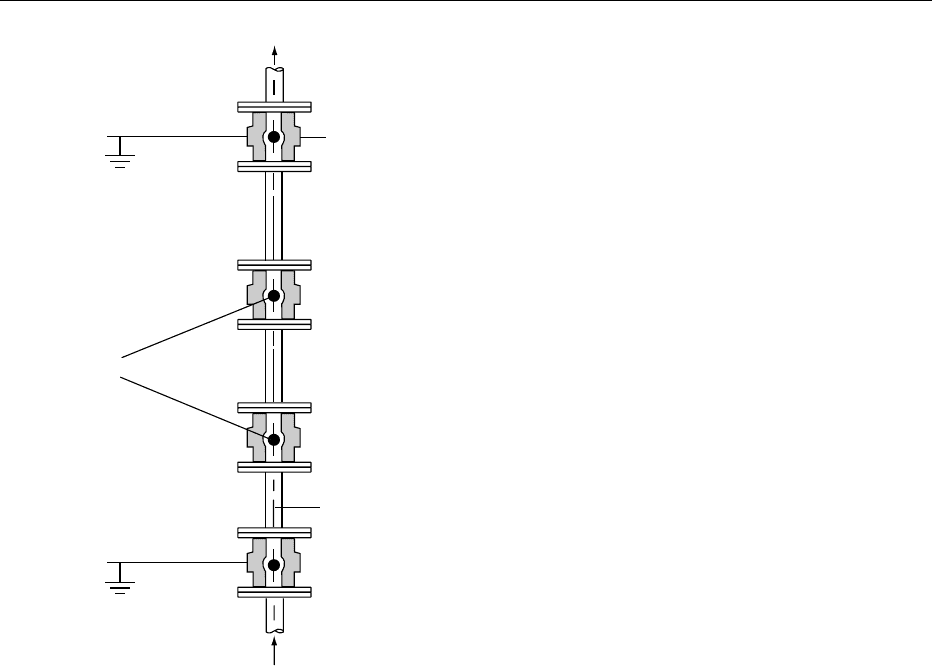Caballero B. (ed.) Encyclopaedia of Food Science, Food Technology and Nutrition. Ten-Volume Set
Подождите немного. Документ загружается.


equipment and the processing environment must be
maintained, cleaned, and sanitized to ensure that
microbial build-up and spread are prevented. Staff
must be trained in practices to maintain high stand-
ards of hygiene. A supply of good-quality water and
air for the process is also essential. Many factories
now have ongoing monitoring systems for Salmonella
and Listeria in place. If these bacteria are detected in
the processing environment, special clean-up regimes
and extra product testing are implemented.
0016 The modern approach to ensuring that milk
powder is microbiologically safe involves preventa-
tive management to ensure manufacture under appro-
priate conditions of hygiene. Many factories now
either have in place, or are moving towards, the
hazard analysis critical control point (HACCP)
system. Although end-product testing is still used to
verify compliance and to detect gross process failures,
it cannot be relied upon to ensure the safety of a batch
of product. Testing can be labor-intensive and time-
consuming, taking up to 7 days to obtain final results.
To overcome these problems, samples may be com-
posited and rapid techniques for detection of patho-
gens based on ELISA or DNA methods applied. These
methods have advanced efficiencies in testing, and
product can now be cleared in 24–48 h. (See Hazard
Analysis Critical Control Point; Quality Assurance
and Quality Control.)
Physical Properties
0017 The physical properties of milk powders are governed
by process variables, the type of dryer, and the com-
position of the milk. The physical properties of milk
powders play an important role in their use as food
ingredients. Their ability to be readily incorporated
into products and to perform specific functions in a
food formulation can be influenced by many physical
properties. There are many physical attributes that
must be taken into account when either evaluating
a current product, setting specifications for new
products or designing or modifying a drying system.
Tighter and more demanding specifications have
meant that powders are now often manufactured on
specialist dryers designed specifically to produce the
best possible product of defined specification.
Moisture
0018 The final moisture content is critical for several
reasons and is therefore defined in all powder specifi-
cations. It can affect functionality and microbio-
logical quality, and is an economic consideration in
the manufacture of powders. There are several factors
during manufacture that can influence the moisture
content of powders. These include the characteristics
of the concentrate fed into the dryer, the type of
atomization used, and the operating conditions
during drying.
Insolubility Index
0019The insolubility index of a powder is a measure of the
degree to which it can be readily solubilized in water
prior to use. It is related to the amount of sediment
obtained under defined conditions of mixing milk
powders. The main reason for loss of solubility is
the temperature of the particles during the primary
stage of the drying process where the majority of the
moisture is removed. During this stage, an imperme-
able crust can form on the particle surface that
severely restricts water removal, leading to the pro-
duction of case-hardened particles and subsequent
loss of solubility.
Bulk Density and Particle Density
0020Bulk density is the amount of powder by weight that
is present in a defined volume. It is usually expressed
as g ml
1
and is obtained by measuring the volume of
a fixed weight of powder after it has been tapped for a
defined number of times. A high bulk density is very
important in packaging and transportation, and is
desirable as it can significantly reduce costs. The
bulk density is influenced by a range of factors.
These include the amount of air entrapped in the
powder particles (occluded air), the overall density
of the particle (determined by the composition), the
air between the individual powder particles (intersti-
tial air), the particle size distribution and the particle
shape. The bulk density of powders is influenced by
dryer design and configuration (Tables 2 and 3). Par-
ticle density is the density of the solids (determined by
the composition), which determines the particle dens-
ity, together with the amount of occluded air.
Particle Size Distribution
0021The individual particles produced during drying can
vary greatly in size. The distribution of particle size
then can be further altered by the degree of agglomer-
ation or after grinding. An indication of the range of
particle sizes obtained from different dryer configur-
ations is given in Table 4.
Interstitial Air and Occluded Air
0022Interstitial air is the amount of air that exists between
particles or agglomerates as well as the air inside
porous agglomerates. The sphericity of the particles,
the particle size distribution, and the degree of ag-
glomeration determine the amount of interstitial air.
To obtain minimum interstitial air, the particles need
to be smooth, have a range of particle sizes, and be in
compact agglomerates.
POWDERED MILK/Characteristics of Milk Powders 4705

0023Occluded air is the amount of air entrapped within
the powder particles. It is affected by the preheat
treatment of the original milk, with a higher pretreat-
ment of milk resulting in less occluded air, and the
amount of air incorporated in the concentrate.
Higher total solids generally result in lower occluded
air. Powders atomized by a nozzle contain less air
than rotary atomized powders, despite improvements
to the modern rotary atomizers. Gentle drying also
reduces the level of occluded air, and therefore, the
use of multistage dryers is recommended for the pro-
duction of powders with low occluded air.
Flowability
0024With the ever-increasing diversity of use of milk
powders today, the need for properties such as
tbl0002 Table 2 Ability of various spray dryers to manufacture nonagglomerated and agglomerated skim milk powder with low or high bulk
densities
Typ e o f dr yin g
process
Chamber
configuration
Postprimary treatment Atomizer type Nonagglomerated
skim milk powder
Agglomerated
skim milk powder
Low BD
a
High BD
a
Low BD
a
High BD
a
Single stage Conventional None Rotary/nozzle Yes Yes No No
Tall form None Nozzle Yes Yes No No
Conventional Cooling bed Rotary/nozzle Yes Yes No Yes
Tall form Cooling bed Nozzle Yes Ideal No Yes
Two stage Conventional External bed Rotary/nozzle Yes Yes No Yes
Tall form External bed Nozzle Yes Ideal No Yes
Compact Integrated bed Rotary/nozzle Ideal Ideal No No
Three stage Compact Integrated bed þ external bed Rotary/nozzle Yes Yes No Yes
Multistage Integrated bed þ external bed Rotary/nozzle Yes Yes Ideal Ideal
Integrated belt Integrated belt Nozzle Ideal No Yes Yes
a
BD ¼bulk density; nonagglomerated skim milk powder: low bulk density 0.72 g ml
1
; high bulk density 0.72 g ml
1
; agglomerated skim milk powder:
low bulk density 0.30–0.50 g ml
1
; high bulk density 0.45–0.55 g ml
1
.
Adapted from Pisecky J (1997) Handbook of Milk Powder Manufacture, p. 79. Copenhagen: Niro A/S.
tbl0003 Table 3 Ability of various spray dryers to manufacture nonagglomerated and agglomerated full-cream milk powder with low or high
bulk densities
Typ e o f dr yin g
process
Chamber
configuration
Postprimary treatment Atomizer type Nonagglomerated
full-creammilk powder
Agglomerated
full-creammilk powder
Low BD
a
High BD
a
Low BD
a
High BD
a
Single stage Conventional None Rotary/nozzle Yes Yes No No
Tall form None Nozzle Yes Yes No No
Conventional Cooling Bed Rotary/nozzle Yes Yes No Yes
Tall form Cooling Bed Nozzle Yes Yes No Yes
Two stage Conventional External bed Rotary/nozzle Yes Yes Yes No
Tall form External bed Nozzle Yes No Ideal No
Compact Integrated bed Rotary/nozzle No Ideal Ideal No
Three stage Compact Integrated bed þ external bed Rotary/nozzle Yes Yes Yes No
Multistage Integrated bed þ external bed Rotary/nozzle Ideal Yes No Ideal
Integrated belt Integrated belt Nozzle Yes No No Yes
a
BD ¼bulk density; nonagglomerated full-cream milk powder: low bulk density 0.63 g ml
1
; high bulk density 0.63 g ml
1
; agglomerated full-cream
milk powder: low bulk density 0.30–0.50 g ml
1
; high bulk density 0.45–0.55 g ml
1
.
Adapted from Pisecky J (1997) Handbook of Milk Powder Manufacture, p. 79. Copenhagen: Niro A/S.
tbl0004 Table 4 Mean particle size obtained from dryers of different
configuration
Powder characteristics Dryerconfiguration Particle size
(mm)
Individual particles Concurrent with
pneumatic conveying
20–200
Tall form – tower 30–250
Flakes Roller dryer 200–5000
Loose agglomerate Mixed flow with
integrated fluid bed
100–400
– open structure Concurrent with
integrated fluid bed
100–200
Compact agglomerate Concurrent spray dryer
with integrated belt
300–2000
– porous structure Mixed flow with
integrated fluid bed
100–400
From personal communication (E. Refstrup), Niro A/S, Denmark.
4706 POWDERED MILK/Characteristics of Milk Powders

flowability is increasing. Powders are used in applica-
tions ranging from dispensing machines through to
the large-scale recombining operations that utilize
mechanical handling and dosing. For both agglomer-
ated and nonagglomerated powders, a better flow-
ability can be obtained by producing larger powder
particles with smooth and rounded particle surfaces
within a narrow particle size distribution. Flowability
is also influenced by other factors such as total fat in
the powder and the amount of ‘free fat.’
‘Free Fat’
0025 ‘Free fat’ in powder is defined as the fat fraction that
is extractable by organic solvents under specific con-
ditions of solvent type, time, and temperature of ex-
traction. In most instances, ‘free fat’ is considered a
defect. The exception is where ‘free fat’ is required for
a specific application, e.g., chocolate manufacture.
One of the most critical influences of ‘free fat’ is the
moisture content of the powder. If the moisture is too
low (< 2.5%), ‘free fat’ increases and then decreases
as the moisture content is raised from 2.5 to 4–5%
but increases again if the moisture content is > 6–7%.
Instant Properties
0026 Very fine powder particles are difficult to handle and
have poor reconstitution properties. Agglomeration of
powders allows water to permeate the powder particles
more readily, breaking up the agglomerate and
allowing the individual powder particles to dissolve.
Instant milk powder is highly soluble and designed to
reconstitute completely in water at both hot and cold
temperatures. The other properties required in instant
powders are wettability and dispersibility. The wett-
ability of a powder is measured by determining the
time taken for a given amount of powder to pass
through the surface of water. Wettability may be en-
hanced by lecithination. The dispersibility of a powder
is a measure of how completely a powder dissolves
under controlled conditions. Other tests carried out
on milk powders related to their instant properties
include slowly dispersible particles, coffee test, white
flecks number (minute particles that are seen on the
surface of reconstituted milk), and the sludge test.
Color
0027 The color of a powder is determined by composition,
preheat treatment, drying conditions, and particle
size distribution. Scorched particles can be a visual
defect that will often show up as deposits on the
bottom of mixing vats and in strainers.
Other Properties
0028 Apart from the properties described above, there are
others that influence a powder’s acceptability. These
include the mechanical stability of the powder, which
influences the degree of agglomeration breakdown
during transport and storage, hygroscopicity, which
is related to the degree of water attraction a powder
exhibits, and cakiness, an attribute that is a measure
of the extent to which a powder adheres to itself,
especially under compression. (See Agglomeration;
Drying: Spray Drying; Rheological Properties of
Food Materials.)
Chemical Characteristics
0029The chemical properties of milk powders are deter-
mined by the composition of the milk and the heat
treatment applied during powder manufacture.
Chemical Composition
0030Skim and full-cream milk powders are obtained by
dehydration of skim milk and full-cream milk to
4% moisture. Full-cream milk is usually standard-
ized to a fat:solids-nonfat ratio of 1:2.67 to meet the
26% legal minimum fat content for this powder. The
protein content of skim milk powders may be stand-
ardized also. Variations in milk composition owing to
factors such as cow breed, feed, stage of lactation,
and season are reflected in the composition of milk
powders. The American Dairy Products Institute
standards for skim and full-cream milk powder com-
positions are as follows: skim milk powder should
have a maximum fat content of 1.25% and a max-
imum water content of 4.0%, whereas full-cream
milk powder should have a minimum fat content
of 26% and a maximum water content of 4.0%.
Control of the moisture content of milk powders to
a maximum of 4% is essential for good shelf-life
stability. Table 5 shows the range of values observed
in milk powder.
tbl0005Table 5 Composition of milk powders
a
Constituent Skim
milk powder
Full-cream
milk powder
Moisture (g per 100 g) 3–5 2–4
Fat (g per 100 g) 0.7–1.3 25–28
Crude protein (g per 100 g) 35–37 25–27
Lactose (g per 100 g) 49–52 36–38
Citric acid (g per 100 g) 1.8–2.1 1.3–1.4
Ash (g per 100 g) 7.5–8.0 6.0–7.0
Sodium (mg per 100 g) 400–550 370–420
Potassium (mg per 100 g) 1550–1750 1150–1350
Calcium (mg per 100 g) 1200–1300 900–1000
Magnesium (mg per 100 g) 110–140 85–100
Phosphorus (mg per 100 g) 950–1050 700–770
Chloride (mg per 100 g) 1100 750–800
a
Adapted from Walstra P and Jenness R (1984) Dairy Chemistry and
Physics, pp. 418–419. New York: John Wiley.
POWDERED MILK/Characteristics of Milk Powders 4707

0031 Another important indicator of milk powder qual-
ity is the titratable acidity of the reconstituted
powder. This is an indicator of the microbiological
quality of the milk. The American Dairy Products
Institute sets a maximum of 0.15% for titratable
acidity of skim milk powder.
Heat-treatment Classification
0032 The characteristics of milk powder can be influenced
by the heat treatment received by the milk powder
during manufacture. The time and temperature of the
preheat treatment affects the level of whey-protein
denaturation. The whey-protein nitrogen index,
which is a measure of the undenatured whey-protein
nitrogen in the powder and was developed by the
American Dairy Products Institute, is commonly
used to classify powders into low-heat, medium-heat
and high-heat milk powders. Typical preheat treat-
ments used for the manufacture of these powders are
listed in Table 6. As the composition of milk, includ-
ing the initial level of whey proteins in milk, can vary
with season, the same heat treatment can result in a
different whey-protein nitrogen index. Other
methods for heat classification of milk powders,
such as the heat number, cystine number, and thiol
number also may be used as a measure of the heat
treatment given to the milk during powder manufac-
ture. (See Heat Treatment: Ultra-high Temperature
(UHT) Treatments.)
Functional Properties of Milk Powders
0033 When milk powders are used as ingredients in food
applications, they contribute to the physical attri-
butes of the food. The ability of milk powders to
impart desirable properties to food is related primar-
ily to functional properties of milk-protein compon-
ents in the powders. These functional properties
include solubility, hydration, heat stability, viscosity,
gelling, foaming, and emulsifying. In milk powders,
the functional properties of the milk proteins may be
modulated by heat, ions, and other components. Heat
treatment of milk prior to concentration and drying is
the most common method used to alter the functional
properties of milk powders. Milk powders with the
same composition given different preheat treatments
prior to concentration and drying have different func-
tional attributes when used as ingredients.
Solubility
0034Solubility is a fundamental functional property that is
a prerequisite for most other desired functionalities.
The solubility of milk powders is dependent on pH.
Proteins have a minimum solubility at the isoelectric
pH, and solubility is increased on the acid and alka-
line side of this pH. Caseins, the major proteins in
milk, are least soluble at pH 4.6.
Hydration
0035Hydration is related to the ability of the milk proteins
to bind or entrap water. Caseins hold about 3.3 g of
water per gram, whereas undernatured whey proteins
hold 0.4 g of water per gram. Heat denaturation of
whey proteins increases the water holding to 2.5 g of
water per gram. Milk powder contains other com-
ponents, such as lactose, that bind water in addition
to the protein. Skim milk powders have a water sorp-
tion of 0.96–1.28 g water per gram, depending on the
conditions used during powder manufacture.
Heat Stability
0036Heat stability is an important property in certain
applications such as the manufacture of recombined
evaporated milk. Single-strength milks made from
low-, medium- or high-heat milk powders have a
similar heat stability to fresh milk. They are heat-
stable at the pH of milk (pH 6.7), being able to
withstand coagulation for up to *20 min at 140
C.
However, for adequate heat stability of evaporated
milks under sterilization conditions (e.g., 120
C for
12 min), high-heat milk powders are necessary. Heat
stability is affected by the pH of the milk, mineral
content, and other components in the milk (e.g.,
lecithin, urea).
Viscosity
0037The viscosity of milks reconstituted from milk
powders is dependent on their state of dispersion,
concentration of solids, and temperature. Increasing
the concentration of milk solids increases the viscos-
ity. Decreasing the temperature increases the vis-
cosity, but heating milk to a temperature that results
in denaturation of whey proteins also increases the
viscosity.
tbl0006 Table 6 Heat classification of skim milk powder
Heat class Whey protein nitrogen index
a
(milligrams of undenatured
whey protein N per gram
of powder)
Preheat treatment
of milk
b
Low heat Not less than 6 72
C for 15 s
Medium heat 1.51–5.99 75
C for 3 min
High heat Not more than 1.5 90
C for 10 min
120
C for 2 min
a
From American Dairy Products Institute (1990) Standards for Grades of Dry
Milks including Methods of Analysis, Bulletin 916.
b
A range of other preheating conditions may be used to achieve a desired
whey protein nitrogen index.
4708 POWDERED MILK/Characteristics of Milk Powders

Gelation
0038 Milks reconstituted from milk powders have the abil-
ity to form gels under similar conditions to those
required for the formation of gels from fresh milk,
i.e., by rennet action for formation of rennet gels and
by acidification of milk under quiescent conditions.
Foaming and Emulsifying
0039 Milk powders can be used in applications where
foaming and emulsifying properties are required.
The ability of milk proteins in the milk powders to
stabilize foams and emulsions may be exploited when
these properties are required. (See Aerated Foods;
Emulsifiers: Uses in Processed Foods; Mixing of
Powders.)
Functional Requirements of Milk Powders
in Major Food Applications
0040 For milk powders to have the desired performance in
food applications, the functional characteristics of the
powders have to be matched to the application. This
requires an understanding of the required functional
properties of the milk powder ingredients in the target
application.
Milk Powders for Recombined Dairy Products
0041 A significant amount of milk powder is used in the
manufacture of reconstituted and recombined dairy
products. In these applications, the milk powders are
combined with water and milkfat to reestablish the
fat:solids-nonfat:water ratio of milk or other dairy
products. Some of the major applications of milk
powders in the recombination industry are for the
preparation of pasteurized fluid milk, UHT milk,
cream, evaporated milk, sweetened condensed milk,
yogurt and cultured dairy products, recombined
cheese, and icecream. Different functionalities of the
milk powder ingredients are needed in these various
recombined dairy products. Table 7 lists the major
functional requirements of milk powders for recom-
bined dairy products.
0042 Pasteurized milks and UHT milks These products
have a similar composition to fresh milk. For pasteur-
ized milks, low-heat or medium-heat powders are
used to obtain a flavor similar to milk and to minim-
ize heat-induced flavors. In the case of UHT milks,
any type of powder can be used, as single-strength
milks made from low-, medium-, or high-heat
powders are stable to UHT conditions.
0043 Evaporated milks It is essential to use high-heat
powders for this application to obtain evaporated
milk with the desired viscosity. A high-preheat treat-
ment improves the heat stability of a recombined milk
concentrate (typically 26% total solids; 18% solids-
nonfat: 8% fat) to in-can sterilization conditions used
in its manufacture. Additionally, high-heat powders
are screened using heat-stability tests to ensure
that they withstand sterilization without excessive
thickening or coagulation.
0044Sweetened condensed milk This is a traditional
dairy product containing 74% total solids (20%
milk solids nonfat: 8% fat: 46% sucrose). The most
important physical attribute of this product is its
viscosity. Low- and medium-heat powders are used
in this application. Milk powders given a high-heat
treatment (e.g., 85
C for 30 min) cannot be easily
processed, because the high viscosity of concentrates
made from these powders also results in rapid age
thickening during storage of the product. There are
a number of viscosity tests that may be used as indi-
cators of suitability of powders for sweetened con-
densed milk manufacture.
tbl0007Table 7 Functional requirements of milk powders in recom-
bined dairy products and selected processed foods
Product Functionalproperties
required inmilk
powder
Heat treatment
of milkpowder
Pasteurized milk Good flavor Low–medium heat
Emulsifying
UHT milk Good flavor Low–medium–high heat
Heat stability
Emulsifying
Cream Good flavor Low–medium heat
Emulsifying
Evaporated milk Heat stability High heat
Viscosity
Sweetened
condensed
milk
Viscosity Low–medium heat
Yogurt Water-binding Low heat
a
Viscosity
Gelling
Cheese Rennetability Low heat
Icecream Foaming/whipping Low–medium–high heat
Emulsifying
Confectionery Water-binding High heat
Foaming/whipping
Emulsifying
Heat stability
Bakery Water-binding High heat
Foaming/whipping
Emulsifying
Gelling
a
If a low-heat milk powder is used, the yogurt milk has to be given a high-
heat treatment during yogurt manufacture. Alternatively, a high-heat milk
powder may be used, in which case, the yogurt milk requires only a low-
heat treatment to pasteurize the milk during yogurt manufacture.
POWDERED MILK/Characteristics of Milk Powders 4709

0045 Yogurt Milk powders may be used as a partial or
total replacement for fresh milk in this application.
Viscosity development, gelling, and good water-
binding properties are necessary for the production
of high-quality yogurts. These properties are obtained
in yogurt by preheating the yogurt milk at a tempera-
ture that causes significant denaturation of whey
proteins (e.g., 90
C for 10 min). Low-heat milk
powder may be used if a high-heat treatment is
given during yogurt manufacture. If a high-heat
milk powder is used, the yogurt milk requires only a
low-heat pasteurization treatment during yogurt
manufacture.
0046 Cheese Only low-heat milk powders are suitable for
recombined cheese manufacture. This ensures good
rennetability of the reconstituted milk. With a high-
heat treatment of milk, there is association of the
denatured whey proteins with the casein, which
hinders the reaction of the rennet.
0047 Ice cream Milk powders contribute to the flavor
and texture of ice cream. The milk powder aids
in the emulsification of the ice cream mix and has a
role in the development of an aerated matrix. (See
Condensed Milk; Evaporation: Basic Principles;
Uses in the Food Industry; Recombined and Filled
Milks.)
Milk Powders for Selected Food Applications
0048 Milk powders are used as functional ingredients in a
number of processed foods.
0049 Chocolate and confectionery products Milk powders
contribute to the flavor, color, and texture develop-
ment in chocolate and confectionery applications.
The emulsifying properties of the milk proteins influ-
ence the miscibility of the ingredients used in choc-
olate and confectionery, hence influencing flow
properties and texture. In confectionery products
such as toffee, good water-binding properties of
milk proteins contribute to the texture of these prod-
ucts. The Maillard reaction, which is the reaction of
the amino groups of the proteins with reducing sugars
in the formulation, is responsible for color develop-
ment and for the production of caramelized flavors;
the lactose in milk powders participates in the Mail-
lard browning reactions.
0050 Bakery products High-heat milk powders are useful
in bakery applications. In addition to enhancing the
nutritive value of cereal-based baked goods, milk
powders contribute to the texture and flavor of these
products. Their emulsification and foam-stabilization
properties and their ability to participate in the
Maillard browning reaction are important require-
ments in bakery applications.
0051Other applications The functional properties of
milk powders also make them useful in a number of
other applications, such as processed meat products,
soups, gravies, and dips.
Characteristics of Stored Milk Powders
0052The characteristics of milk powder are dependent on
the quality and composition of the raw milk and the
manufacturing process used during its manufacture.
However, even if milk powders are manufactured to
meet the desired standards and specifications,
changes in the properties of milk powders may
occur during storage and distribution. The compos-
ition of the powder, the type of packaging material
used, and the conditions of handling and storage
influence the shelf-life of the powder.
0053Deterioration of milk powders resulting from
Maillard browning, lactose crystallization, and
oxidation of fat may lead to flavor and physical
defects in the powder. It may also affect the function-
ality of the milk powder when it is used in a
food product. Some of the changes that may occur
during storage include the development of a
brown color, a reduction in pH, reduced solubility,
development of off-flavors, and reduced heat stability
of powders.
See also: Biofilms; Condensed Milk; Emulsifiers: Uses
in Processed Foods; Evaporation: Basic Principles; Uses
in the Food Industry; Heat Treatment: Ultra-high
Temperature (UHT) Treatments; Mixing of Powders;
Pasteurization: Principles; Rheological Properties of
Food Materials; Powdered Milk: Milk Powders in the
Marketplace; Quality Assurance and Quality Control;
Recombined and Filled Milks
Further Reading
American Dairy Products Institute (1990) Standards for
Grades of Dry Milks Including Methods of Analysis,
Bulletin 916, rev ed. Chicago, IL: ADPI.
Early R (1998) Milk concentrates and milk powders. In:
Early R (ed.) The Technology of Dairy Products, 2nd
edn, pp. 228–300. London: Blackie Academic & Profes-
sional.
International Commission on Microbiological Specifica-
tions for Foods (1998) Microorganisms in Foods 6,
Microbial Ecology of Food Commodities. London:
Blackie Academic & Professional.
International Dairy Federation (1984) General Code of
Hygienic Practice for the Dairy Industry and Advisory
Microbiological Criteria for Dried Milk, Edible Rennet
4710 POWDERED MILK/Characteristics of Milk Powders

Casein and Food Grade Whey Powders, Bulletin No.
178. Brussels: International Dairy Federation.
International Dairy Federation (1990) Recombination of
Milk and Milk Products, Special Issue No. 9001. Brus-
sels: International Dairy Federation.
International Dairy Federation (1991) IDF Recommenda-
tions for the Hygienic Manufacture of Spray Dried Milk
Powders, Bulletin No. 267. Brussels: International Dairy
Federation.
International Dairy Federation (1999) 3rd International
Symposium on Recombined Milk and Milk Products,
Special Issue No. 9902. Brussels: International Dairy
Federation.
Knipschildt ME and Andersen GG (1994) Drying of milk
and milk products. In: Robinson KR (ed.) Modern Dairy
Technology, 2nd edn., vol. 1, pp. 159–254. London:
Chapman & Hall.
Masters K (1997) Spray dryers. In: Baker CGJ (ed.) Indus-
trial Drying of Foods, pp. 90–112. London: Blackie
Academic & Professional.
Mettler AE (1994) Present day requirements for effective
pathogen control in spray dried milk powder production.
Journal of the Society of Dairy Technology 47: 95–107.
Pisecky J (1986) Standards, specifications, and test methods
for dry milk products. In: MacCarthy D (ed.) Concen-
tration and Drying of Foods: Proceedings of the Kellogg
Foundation 2nd International Food Research Sympo-
sium (Cork: 1985), pp. 203–220. London: Elsevier
Applied Science.
Pisecky J (1997) Handbook of Milk Powder Manufacture.
Copenhagen: Niro A/S.
Walstra P and Jenness R (1984) Dairy Chemistry and Phys-
ics, pp. 418–419. New York: John Wiley.
POWER SUPPLIES
Use of Electricity in Food
Technology
D Graham, R and D Enterprises, Walnut Creek, CA,
USA
Copyright 2003, Elsevier Science Ltd. All Rights Reserved.
Introduction
0001 The food industry in the USA consumed 17.4 billion
kcal in 1999. Fifty-eight percent of total food industry
energy costs are from electricity. The industry pur-
chases 64.0 billion kWh of electricity annually at a
cost of $3.36 billion. Purchased energy is 1.3% of the
value of product shipments for the food industry
compared with 1.7% for the total US industry.
0002 Major uses of electricity include freezer and re-
frigeration compressors, conveyors, air handling,
pumping, lighting, process controllers and monitors,
and packaging forming and sealing. Natural gas is the
primary source of thermal energy for ovens, fryers,
dryers, evaporators, and boilers, with relative costs
being the main reason. Closely related uses of electri-
city in agricultural food production include crop
irrigation, pest control, produce disinfection, grain
harvesting and storage, weed reduction, livestock
waste management, and fish farming.
0003 Irradiation, ohmic heating, microwave processing,
ozonation, freeze concentration, nonthermal pasteur-
ization, and the use of heat pumps are examples of
relatively new electrotechnologies that the food indus-
try may apply increasingly in the future. Application of
these technologies provides opportunities for food
processors to improve operating efficiencies and
helps insure the quality and safety of processed food
products.
Electricity Use by Food Industry Sectors
0004Food energy costs rose steadily over the past two
decades. In 1996, purchased electricity comprised
over half of the total energy used in food processing.
Electrical consumption by grain milling, meat pro-
cessing, preserved fruits and vegetables accounts for
23, 19, and 13%, respectively, of the total food indus-
try use of electricity. Some food processors operate
cogeneration facilities using surplus heat to produce
electricity, but approximately 92% of total electricity
used by the food industry in the USA is purchased
from utility companies. Approximately 87% of the
electricity is used by motor-driven equipment such
as compressors, pumps, mixers, grinders, fans, etc.
Table 1 compares the cost of electricity with total
energy costs in food processing. Electricity consump-
tion has increased approximately 3% annually from
48.9 billion kWh in 1986 to 69.1 billion kWh in
1999. Table 2 shows the trends in electric energy
cost from 1980 to 1996.
New Electrotechnologies for Food
Processing and Preservation
0005Electron beam irradiation, X-ray, microwave process-
ing, membrane separation technology, ozonation,
ohmic heating, high pressure pasteurization, infrared
POWER SUPPLIES/Use of Electricity in Food Technology 4711

radiation, laser, ultraviolet light, freeze concentration,
and pulsed electric fields are developing technologies
that offer future potential for improvements in food
safety, quality, and more efficient processing.
Irradiation of Food Products
0006 Treatment of a food product with a controlled source
of irradiation can be very effective for improving the
safety of the food product, since the irradiation can
destroy any viable food pathogens that may be pre-
sent. Food products are not made radioactive when
irradiated, and no toxic byproducts are formed.
Irradiation has been used successfully on a variety
of products, including cereals, fruits, vegetables,
prepared foods, dairy products, meat and poultry,
beverages, spices, and seasonings. Products can be
irradiated after being sealed in packaging material,
which reduces the possibility of contamination by
handling after treatment.
0007 Safety of irradiated foods Controversy has sur-
rounded the use of food irradiation since its discovery
in the late 1940s. Much concern has resulted from
fear that the irradiation process might make the food
radioactive. Treatment of food with gamma irradi-
ation does not inject radioactivity into the food.
High-energy electrons pass through the food product
and, if sufficient energy is applied, kill microorgan-
isms that they impact. In approving food irradiation,
the Food and Drug Administration (FDA) reviewed
over 400 toxicity studies, including animal feeding
studies before issuing any approvals. The FDA con-
cluded that food irradiated up to 1 kGy is ‘‘whole-
some and safe for human consumption, even where
the food that is irradiated may constitute a substantial
portion of the diet . . . ’’
0008Electron beam irradiation may provide an effective
way to control harmful E. coli 0157:H7 and other
emerging pathogens in ground beef and other pro-
cessed meat products such as pork sausage and re-
frigerated poultry. Electron beams (gamma rays) from
machine sources up to 10 million electron volts (10
MeV) and X-rays generated from machine sources up
to 5 MeV are permitted commercially. Similar ener-
getic rays also can be produced by decay from sealed
units of radioactive sources such as cobalt-60 or
cesium-137. Gamma rays are used effectively for ster-
ilizing a variety of products including food packaging
materials, syringes, bandages, and other heat-sensi-
tive pharmaceutical products. X-rays also are effect-
ive in some applications. One kilogray is 1 J of energy
absorbed per kilogram of the substance being irradi-
ated. The FDA has approved electron beam radiation
providing absorbed doses of radiation from 0.2 to
7.0 kGy, depending of the particular food product.
Table 3 lists the radiation levels approved by the
FDA for food products.
Microwave Heating
0009Microwave ovens found extensive use in home food
preparation and in commercial food service during
the past two decades. Industrially, microwaves are
used primarily for tempering, thawing large blocks
of frozen meat, and preheating. Studies of microwave
application for sterilization of food products have
shown limited success.
0010Microwaves are electromagnetic waves similar to
TV, radio, light, radar, or infrared waves, with the
main difference being the frequency of the wave
motion. Food products contain molecules such as
water, salts, and proteins that have dipolar properties.
Microwave energy passing through a food product
causes these dipolar molecules to vibrate. The resulting
internal friction produces heat. Thus, the food prod-
uct is heated from within, and heating time is greatly
reduced compared with heating by external applica-
tion of heat. This rapid heating provides improved
food quality and energy savings in many applications.
tbl0002 Table 2 Growth of electricity use in food processing as a
percentage of the total energy cost
1980 1986 1994 1996
Total food 41.0 51.8 57.4 58.0
Meat products 51.4 59.6 69.2 68.5
Dairy products 47.3 58.8 66.1 64.3
Preserved fruit/vegetables 37.3 52.1 55.8 57.1
Grain mill products 44.0 53.0 57.5 59.8
Bakery products 43.3 47.9 55.7 56.6
Sugar/confectionery n/a 35.9 34.9 41.7
Fats and oils 26.8 40.1 42.5 39.4
Beverages 43.1 52.1 61.1 59.1
Miscellaneous 48.0 54.8 53.8 59.1
Source: Annual Survey of Manufactures. US Dept. of Commerce, with
permission.
tbl0001 Table 1 Electricity vs total energy used in food processing
Electricity
($ million)
Total
energy
($ million)
Electricityas
a percentage
of thetotal
Total food industry 3364 5799 58.0
Meat products 614 884 69.5
Dairy products 401 632 62.4
Preserved fruit/vegetables 459 804 57.1
Grain mill products 683 1142 59.8
Bakery products 241 426 56.6
Sugar/confectionery 177 424 41.7
Fats and oils 180 456 30.8
Beverages 345 584 59.1
Miscellaneous 464 447 59.1
Source: 1996 Annual Survey of Manufactures, US Dept. of Commerce, with
permission.
4712 POWER SUPPLIES/Use of Electricity in Food Technology

0011 Microwaves are in the radio frequency portion of
the electromagnetic spectrum between 300 and
300 000 MHz. Microwaves are generated by a mag-
netron that converts electrical energy into an electro-
magnetic field with centers of positive and negative
charges that change direction billions of times a
second. In the USA, the Federal Communication
Commission limits commercial microwave sources
to 915 and 2450 MHz.
0012 Microwave heating is used for cooking or partial
cooking of meat, chicken, other prepared foods, rapid
thawing of frozen meat, poultry, and seafood, drying
of pasta, fruits, and cereal products, freeze drying of
meat and juices, and, pasteurization of milk, yogurt,
beer, and wine. Table 4 shows the penetration of
microwave energy into a variety of food substances
at different temperatures.
Ohmic Heating
0013 Ohmic heating describes an innovative process in
which an electric current is passed directly through a
food product to generate heat by internal resistance
without any need for intermediate heat exchangers.
The electric energy is applied from electrodes inserted
into the product and is converted directly to thermal
energy within the food product with an overall con-
version efficiency of 90%.
0014Food products sterilized by ohmic heating undergo
less damage to flavor and color as compared with
conventional heating methods. Electrical conductiv-
ity of the food product influences the flow of electric
current through the food and can cause uneven heat
distribution. This has been troublesome with some
prepared foods that contain ingredients of varied
composition, size, and shape. Ohmic heating can pro-
cess a wide variety of pumpable products including
stews, dairy sauces, eggs, custards, soups, diced fruits,
pie fillings, etc. Microorganisms present in the food
are killed by heat, just as in conventional heat pro-
cessing. The temperatures required to assure commer-
cial sterility are identical to the temperatures required
in conventional heat processing. The ohmic advan-
tage stems from the rapid temperature increase due
to internally generated heat, making conductance
of heat through the food to the center of the mass
unnecessary, and the 90% conversion of electrical
energy to heat. Conventional heat exchangers achieve
only about 50% transfer of heat to the food product.
Figure 1 shows a typical electrode assembly for ohmic
heating.
0015A typical 75-kW commercial unit capable of
heating 750 kg h
1
uses a 5-cm-diameter electrode
housing. A 300-kW, 3000 kg h
1
unit requires a 10-
mm-diameter housing. A basic ohmic heating system
typically consists of four electrodes in series con-
nected by short spacer tubes. The top and bottom
electrodes are connected to one phase of a three-
phase transformer and are grounded. Each of the two
middle electrodes is connected to one of the other
phases of the transformer. The voltage required for
heating the product is varied by adjusting the primary
side of the transformer.
tbl0003 Table 3 Food irradiation processes approved by the FDA
Yearapproved Food product Dose (kGy) Purpose
1963 Wheat and wheat flour 0.2–0.5 Disinfestation of Insects
1964/5 White potatoes 0.05–0.15 Inhibit sprouting
1983 Spices and seasonings 30 max. Disinfestation of insects
1985 Pork, fresh unheat-processed 0.3–1.0 Control of Trichinella spiralis
1985/6 Dry of dehydrated enzymes 10 max. Control of insects and pathogens
1986 Fruit 1 max. Disinfestation and delay ripening
1986 Fresh vegetables 1 max. Disinfestation of insects
1986 Herbs and spices 30 max. Control of microorganisms
1986 Vegetable seasonings 30 max. Control of microorganisms
1990 Poultry, fresh or frozen 3 max. Control of microorganisms
1995 Meat, frozen and packaged (limited to use by NASA) 44 minimum Sterlization
1995 Animal feed and pet food 2–25 Control of Salmonella
1997 Red meat, uncooked, chilled 4.5 max. Control of microorganisms
1997 Red meat, frozen 7.0 max. Control of microorganisms
tbl0004 Table 4 Microwave energy penetration
Material
temperature (
C)
Half power depth (cm)
915 MHz 2450 MHz
Ice 12 1600 780
Water 2 4 0.6
Water 45 14 2
Water 75 21 3
Water 95 30 5
Beef, lean 51 70 46
Beef, lean 18 10 8
Beef, lean 4 2 2
Beef, lean (freeze-dried) 18 550 190
POWER SUPPLIES/Use of Electricity in Food Technology 4713

Membrane Technology
0016 Membrane technologies separate fluid mixtures in
many different applications. They can separate ma-
terials based on size, electrical nature, physical prop-
erties, and are used widely in the food processing and
chemical industries, as well as in water treatment. All
membrane processes are electrically driven, using
high-velocity/high-pressure pumps.
0017 This technology originated in the early 1930s with
cellulose acetate membranes, and has developed rap-
idly as new and improved media have been created.
The arsenal of membranes now includes a wide range
of polymeric membranes, ceramic, and sintered stain-
less steel. Among many applications are: concentra-
tion of fluid products; sterilization by removal of
bacteria or viruses; removal of constituents such as
proteins, acids, and fats from process streams; desal-
ination; purification; demineralization; refining of
oils; and clarification.
0018 Membrane separation could be considered as a
modern, highly efficient, versatile form of the trad-
itional filtering process. The objective is still the same,
i.e., to remove one component such as small solid
particles from a second component such as a liquid
or to separate a given molecular component from a
solution.
0019The efficiency with which separations can be made
and the wide range of components that can be pro-
cessed with membranes are noteworthy. Separations
can be based on particulate size differences of a less
than 1 mm down to a molecular level. Separation
depends on the passage of specific molecules through
a semipermeable membrane while the membrane
retains other molecules.
0020In traditional simple filtration, the osmotic pres-
sure due to differences in concentration on the two
sides of a membrane, a differential pressure, and/or
gravity were the only driving forces. In membrane
processes, pumps apply high pressure and high
cross-flow velocity to the solution being filtered to
speed up the separation process. High-velocity turbu-
lent flow at the membrane/liquid interface continu-
ously cleans the membrane surfaces and extends their
useful life. In some instances, when strongly highly
ionic systems are being filtered, an electrical potential
will be applied to accelerate the process and increase
selectivity of the separation process.
0021Membrane separations typically are classified into
subtechnologies based on the pore size of the filter
media. Common classifications include microfiltra-
tion (coarsest), ultrafiltration, nanofiltration, and
reverse osmosis (finest). Figure 2 illustrates the
tremendous range and flexibility of the filtration
spectrum. Particle sizes are measured in microns and
alternatively stated as Daltons. (MWCO, molecular
weight cutoff).
0022The ability to concentrate delicately flavored solu-
tions such as fruit juices or dairy products without the
application of heat provides the food processor with
the potential to significantly improve product quality.
The ability to separate components selectively from a
product stream or effluent stream can lead to the
creation of new products, allow recycling or reclaim-
ing of valuable ingredients, or simplify and reduce the
cost of effluent disposal.
0023Membrane filtration has been commercially used
in the USA since about 1930, primarily in the water
and beverage industries. Widespread applications and
use were initially limited due to the lack of practical
membranes. Early membranes tended to clog easily,
were hard to clean, and had short process lives. De-
velopment of new polymeric membranes, or ceramic
membranes in the 1980s provided the food processor
with filtering systems with greater durability, greater
efficiency, far more versatility and lower costs. These
membranes have a higher capacity, are less prone
to clog, are easier to clean, and withstand multiple
Out
Electrode
assembly
Plastic-lined
stainless steel
pipe
Feed in
Electrode
Electrodes
Electrode
fig0001 Figure 1 Typical electrode assembly. Drawing courtesy of
APV.
4714 POWER SUPPLIES/Use of Electricity in Food Technology
